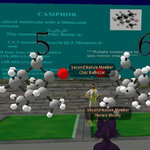Chemistry

Ethylene, the world's most commonly produced organic compound, is used many types of industries. Farmers and horticulturalists use it as a plant hormone to promote flowering and ripening, especially in bananas while doctors and surgeons have long used ethylene as an anesthetic and ethylene-based polymers are found in everything from freezer bags to fiberglass.
Its current production methods result in a number of greenhouse gases. A new environmentally friendly technology created by scientists at Argonne National Laboratory may revolutionize creation of this compound by use of a high-…

Drugs derived from cinchona bark, known as cinchona alkaloids, have been used in healing from ancient times. The most prominent representative of this group is quinine, a bitter substance contained in beverages such as tonic water and used in modern medicine to combat malaria.
As early as 1945, Robert Burns Woodward and William von Eggers Doering (Harvard University) described how to synthesize quinine in the laboratory. The last step of this “formal” total synthesis, a three-step reaction procedure previously described by Paul Rabe and Karl Kindler in 1918, has continued to be the subject…

Water has some amazing properties. It is the only natural substance found in all three states — solid, liquid and gas — within the range of natural Earth temperatures. Its solid form is less dense than its liquid form, which is why ice floats. It can absorb a great deal of heat without getting hot, has very high surface tension (helping it move through roots and capillaries — vital to maintaining life on Earth) and is virtually incompressible.
A less commonly known distinction of water, but one of great interest to physical chemists, is its odd behavior at its transition to the glassy phase.…

Chemical research has traditionally been organized in either experiment-centric or molecule-centric models.
This makes sense from the chemist's standpoint.
When we think about doing chemistry, we conceptualize experiments as the fundamental unit of progress. This is reflected in the laboratory notebook, where each page is an experiment, with an objective, a procedure, the results, their analysis and a final conclusion optimally directly answering the stated objective.
When we think about searching for chemistry, we generally imagine molecules and transformations. This is reflected in the…

Researchers in New Jersey report development of a new type of non-stick material whose ability to shed liquids like water from a duck’s back can be turned on or off simply by flipping an electrical switch.
The material, called “nanonails,” offers a wide-range of potential applications including contamination-resistant and self-cleaning surfaces, reduced-drag ships, and advanced electrical batteries, they say. Their study is scheduled for the Jan. 1 issue of Langmuir.
For years, researchers sought to develop surfaces that repel virtually any liquid. They’ve created non-stick surfaces that…

What are the defining discoveries and great developments that are shaping the way we use materials and technologies today? Materials Today magazine has compiled a list of the top ten most significant advances in materials science over the last 50 years.
The top ten includes advances that have altered all our daily lives. Some have completely changed the research arena, and others have opened up new possibilities and capabilities. They are:
1. The International Technology Roadmap for Semiconductors
2. Scanning probe microscopes
3. Giant magnetoresistive effect
4. Semiconductor lasers and…

This term, the students in my organic chemistry class were presented with an opportunity to do an extra credit assignment using Second Life to represent concepts they learned in the course.
When I was an undergraduate, finding molecules in articles was mainly done using the Chemical Abstracts books. A convenient way to find a specific molecule would be to look up the molecular formula and find the corresponding IUPAC name. Theoretically, one could figure out the IUPAC name from scratch but this can be very tricky for complex molecules and prone to error. With the correct name, I could look…

Scientists in France are reporting for the first time that sculptors from the fantastically wealthy ancient Empire of Mali — once the source of almost half the world’s gold — used blood to form the beautiful patina, or coating, on their works of art.
In a study published in Analytical Chemistry, Pascale Richardin and colleagues describe development of a new, noninvasive test that accurately identifies traces of blood apparently left on ancient African artifacts used in ceremonies involving animal sacrifices.
Archaeologists often had reported or suspected the presence of blood on many African…

The 3-way catalysator of a car apparently works differently from the way chemists had expected. The conversion of carbon monoxide into carbon dioxide takes place not in one single step, but in at least two different steps. To date, the second reaction path was completely unknown, but it seems to work much more efficiently than the first, more familiar process.
This discovery has been made by surface physicist Marcelo Ackermann from Leiden University. His findings call into question the chemistry of catalysators.
Catalysator performance now understood
Because the second reaction path…

In a familiar high-school chemistry demonstration, an instructor first uses electricity to split liquid water into its constituent gases, hydrogen and oxygen. Then, by combining the two gases and igniting them with a spark, the instructor changes the gases back into water with a loud pop.
Scientists at the University of Illinois have discovered a new way to make water, and without the pop. Not only can they make water from unlikely starting materials, such as alcohols, their work could also lead to better catalysts and less expensive fuel cells.
“We found that unconventional metal hydrides…